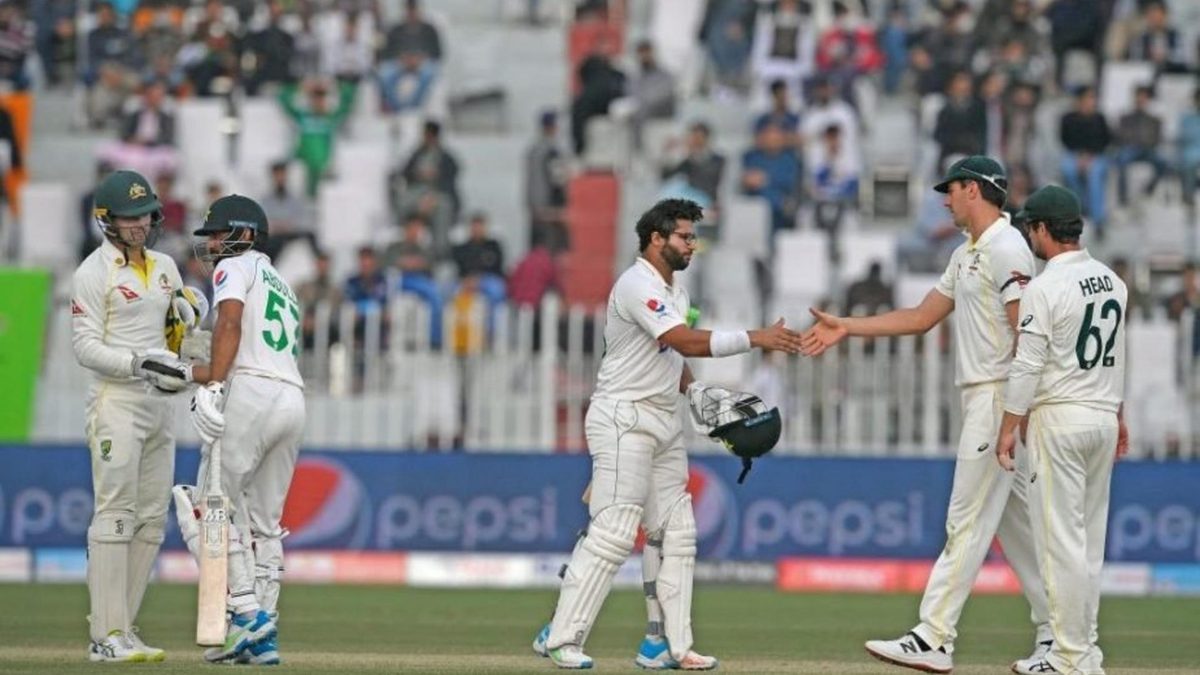
Taha Hashim reports from Rawalpindi on a historic Test match which combined joy, tragedy, and mountains of runs.
It’s manic. Or at least I am. I’ve rocked up to the Rawalpindi Cricket Stadium just under three hours before the first Test between Pakistan and Australia gets underway, but I’m absolutely clueless as to how I can access the ground. At each checkpoint there are swarms of men in uniform with guns close enough to bring about jitters and little time for yours truly: my broken Urdu doesn’t help and the flashy media pass isn’t flashy enough. The focus is, understandably, on the bigger mission: to make sure nothing disrupts this historic event.
Australia’s visit to Pakistan is their first since 1998, marking another significant milestone in the return of international cricket to the country. After Sri Lanka’s team bus was attacked in Lahore in 2009, it took a decade for Test cricket to make its comeback here. Gradually, the game is coming home, but that’s not to say there haven’t been a few hiccups. When New Zealand and England pulled out of limited-overs visits shortly before last year’s T20 World Cup – the former citing a security alert; the latter offering a statement of little clarity – there was anger in these parts. “We know that [the] Australians will probably do what the New Zealanders and England have done,” said PCB chair Ramiz Raja as he went in hard on cricket’s “western bloc”. But here Australia are.
I do eventually find my way to the media centre, my bag checked on three occasions before I finally make it into the building. An hour before the toss, there’s a press conference to outline just what a big deal this all is, with the chief execs of the ICC, Pakistan Cricket Board, Cricket Australia and the Australian Cricketers’ Association all sat side by side. “This tour is about much more than just cricket,” says the PCB’s Faisal Hasnain. “It’s about mutual respect, understanding and admiration. Whatever the result on the field, whatever the outcome, the ultimate winner will be our glorious game of cricket.” There are also words in tribute to Rod Marsh, the great Australian wicketkeeper who has died earlier that day at the age of 74.
After all the talk of history being made, the time comes for the here and now. Babar Azam wins the toss, chooses to bat first and the early exchanges suggest that he’s called it right with two frontline spinners in his XI. Australia have only picked one and on a pitch offering nothing for the quicks, Pat Cummins turns to Nathan Lyon after just seven overs. But it soon becomes apparent that this isn’t a tweaker’s track either.
On the flattest of tracks, one that will refuse to break up, Imam-ul-Haq celebrates his maiden Test century – his first of two in the match – as an effervescent crowd filters in. The constant blare of horns saturates the air while flags are waved and placards are held up high. There’s love and support – for both teams. The cricket is far from enthralling, but you can’t escape the joy that surrounds it.
Elsewhere, however, there is tragedy. Dozens have been killed in a suicide bombing while attending Friday prayers at a mosque in Peshawar. As I begin to pack my things up at the end of the day, exhausted from my morning laps around the ground but warmed by the occasion itself, whispers at the back of the press box turn into four shattering words: Shane Warne has died. The next day is one of mourning.
The cricket, while mattering very little in the grand scheme of things, serves as a welcome distraction, with various plot lines still tugging at the heart strings. Azhar Ali, who had to wait until his 76th Test to play one in his country, departs to a standing ovation after a marathon 185, while Australia’s Pakistan-born opener Usman Khawaja hits 97, just missing out on a homecoming ton. Throughout, the crowd is still something to marvel at. In fact, such is the occasion, it takes me until the end of day three to realise: this isn’t a very good Test match.
Day four comes and goes and, as we wait for the inevitable handshakes on day five, I venture out into the crowd and get into conversation with a beaming father and his cricket-mad son. The 16-year-old boy is decked out in a Pakistan top, has brought in his own signs, loves Cummins and Labuschagne, and dreams of playing out there on the field one day himself. It seems that even the drabbest of matches can inspire a generation. The pitch doesn’t befit the occasion, but what an occasion it is.








